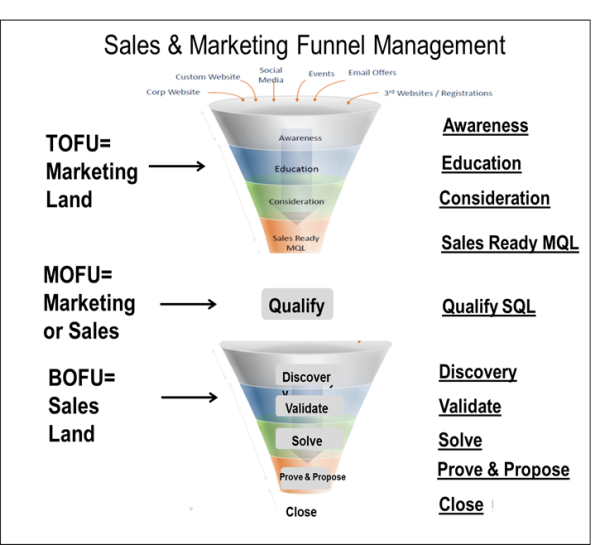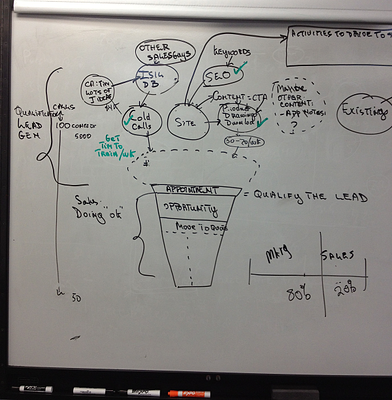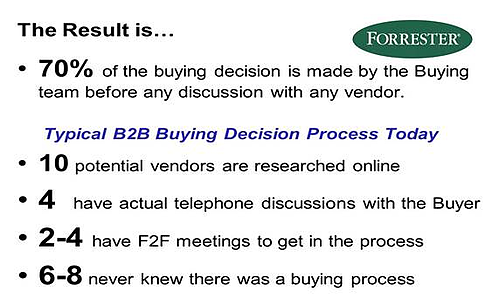
The Classic Derby Sales Funnel. By now, I've probably drawn The Funnel thousands of times. In Whiteboard Sessions. In business planning classes at MIT and in marketing classes at Tufts. It seems that as soon as I see a whiteboard in anyone's office or conference room, I'm mentally reaching for the pens and drawing the now comforting funnel, posing questions as to...
- What type of a sales process do you have?
- Where's the dividing line between Sales and Marketing?
- Where does the actual selling part start?
- What types of selling steps do you use?
- What do you have in the way of sales tools to plug into the steps?

- Where "process" is the name of the game, I'm going to push everyone deeply into the mechanics and the logistics of Funnel Math.
- Where "relationship sales" is the operating DNA of the current sales process, I'll take it slower at the beginning, but ultimately end up in the same place since Relationship Selling is Dead!
After years of drawing sales funnels with steps varying in complexity from five to eight, and toolboxes from simple to complex, again and again, I've realized the most critical step is Discovery. The opportunity, right at the beginning after a salesperson has realized that this is a truely qualified potential to create a scheduled call or a F2F meeting to discover everything that they need to know in order to close a sale.

We know now from research done by Forrester, by Gartner and by Sirius Decisions that 67% to 74% of the B2B buying decision process has been completed before the potential customer ever talks to a salesperson. Given that, the question then needs to be asked...
Just what do I talk about?
OK, I have the Discovery Call scheduled. Maybe, it's a 30 minute conference call; maybe it's a 45 minute meeting. What do I try to squeeze in during that short period of time?
What you don't do is to talk about your product or your service. Unless the buyer is just adamant to buy whatever you have (and, if they were, there wouldn't be any need for a meeting would there?), then you're not ready to sell. You simply don't know enough.
1. First, you absolutely must focus on getting the answers to the questions that you need to know in order to fill the needs of the prospect and close the deal. As a result, one of the most critical sales tools in your toolbox is the Discovery Checklist. 15 to 30 very specific questions that you absolutely need to get answered if you're going to be successful.
Best Practice is that the Discovery Checklist should be a printable, easy-to-access dropdown embedded in your CRM which encompasses all of the detailed questions relating to BANT.
Best Practice confirms that prospective buyers will tell you just about anything if they're asked in the right manner at the right time. And, that time is up front-right at the very beginning of the sales process.
Best Practice also confirms that they will do that only once and are very restentful if the salesperson does not listen well, show sincere interest, write down their responses and probe even deeper.
2. Second, you must learn The Art of Telling Stories.
It used to be that, as a salesguy, prospects and customers would actually look to me for information. Information on products, data on usage, market research information or connections to service providers or potential hires. The Internet and social media fill most of those requirements more robustly than I ever could, and Linked In is much more powerful a database for targeting people than my personal memory banks.
But just on that last point of using Linked In, which I visit 10-20 times a day, what I can do, once someone is identified, is fill in the gaps by telling stories about individuals in the way of recommendations, referrals and personal experiences. I like to think that I'm reasonably well connected, and it's very typical for my business associates to contact me to find out the story behind the Linked In story...even if I've provided a written LI recommendation.
Storytelling in a formal sales process is most often used to:
- Establish common ground at the beginning of a sales process either at the Qualify or the Discovery step. Short stories on common interests, families and where one went to school or grew up are a great tool for "opening the door"...as long as they are kept short and to the point.
- Establish credibility at the end of the definition of your Value Proposition. Once the three components of a Value Proposition equation are defined in terms of the Business Drivers & Movement & Metrics, a story at the end of that definition that provides a customer success example builds immediate credibility and starts the process of creating trust.
- Establish trust in the salesperson as a personal advisor to the buyer and all of the decision makers involved with the product or service at the company. This level of trust-The Trusted Advisor Level-is simply not going to happen unless there's an ability for the salesperson to be seen as someone who is not only heavily experienced and market-knowledgeable, but someone who is primarily interested in the success of that customer. Short stories of other successes achieved in similar circumstances often provide a perfect means to gain that trust.
If you're a professional salesperson, you've probably been hearing and reading more and more about storytelling as a sales tool for the past 12 or 18 months, and I expect that you'll be hearing a lot more over the next year. Like most sales skills, Storytelling is just that-a skill-and all skills can be trained for and practiced such that you can gain credibility relatively quickly and work toward becoming an expert. Don't think that storytelling for anyone is "natural". It's a learned and practiced skill.
The HBR article hyperlinked above is a good place to start for a few basic ideas. Then if you want to do a deeper dive, I would recommend adding to your August beach reading, the recently released, Story Based Selling, by Jeff Bloomfield.
Good Selling...and Good Storytelling!


